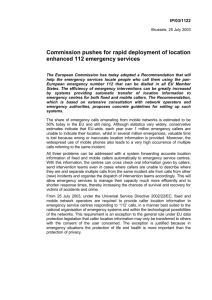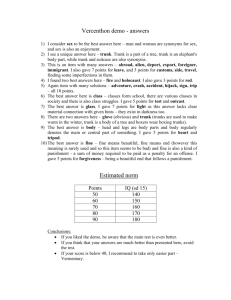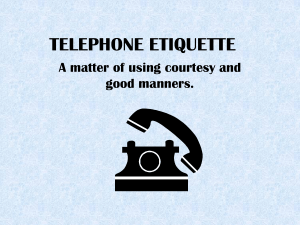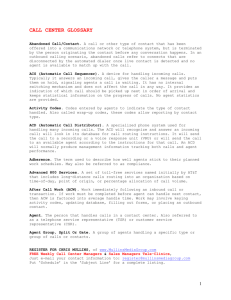Call Center Metrics: Glossary of Terms
advertisement
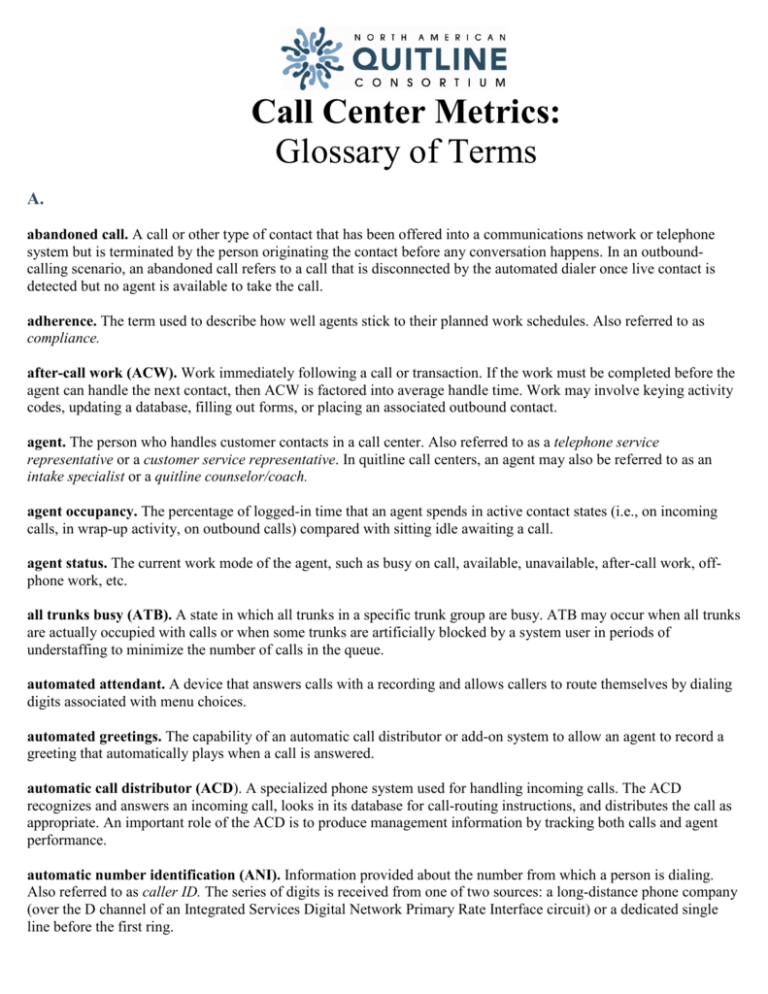
Call Center Metrics: Glossary of Terms A. abandoned call. A call or other type of contact that has been offered into a communications network or telephone system but is terminated by the person originating the contact before any conversation happens. In an outboundcalling scenario, an abandoned call refers to a call that is disconnected by the automated dialer once live contact is detected but no agent is available to take the call. adherence. The term used to describe how well agents stick to their planned work schedules. Also referred to as compliance. after-call work (ACW). Work immediately following a call or transaction. If the work must be completed before the agent can handle the next contact, then ACW is factored into average handle time. Work may involve keying activity codes, updating a database, filling out forms, or placing an associated outbound contact. agent. The person who handles customer contacts in a call center. Also referred to as a telephone service representative or a customer service representative. In quitline call centers, an agent may also be referred to as an intake specialist or a quitline counselor/coach. agent occupancy. The percentage of logged-in time that an agent spends in active contact states (i.e., on incoming calls, in wrap-up activity, on outbound calls) compared with sitting idle awaiting a call. agent status. The current work mode of the agent, such as busy on call, available, unavailable, after-call work, offphone work, etc. all trunks busy (ATB). A state in which all trunks in a specific trunk group are busy. ATB may occur when all trunks are actually occupied with calls or when some trunks are artificially blocked by a system user in periods of understaffing to minimize the number of calls in the queue. automated attendant. A device that answers calls with a recording and allows callers to route themselves by dialing digits associated with menu choices. automated greetings. The capability of an automatic call distributor or add-on system to allow an agent to record a greeting that automatically plays when a call is answered. automatic call distributor (ACD). A specialized phone system used for handling incoming calls. The ACD recognizes and answers an incoming call, looks in its database for call-routing instructions, and distributes the call as appropriate. An important role of the ACD is to produce management information by tracking both calls and agent performance. automatic number identification (ANI). Information provided about the number from which a person is dialing. Also referred to as caller ID. The series of digits is received from one of two sources: a long-distance phone company (over the D channel of an Integrated Services Digital Network Primary Rate Interface circuit) or a dedicated single line before the first ring. NAQC Issue Paper: Call Center Metrics: Glossary of Terms auxiliary work state. A work state other than actively handling calls. As an example, agents may go into an auxiliary work state to process paperwork or e-mails. Agents will not receive calls while in an auxiliary work state. available time. The period of time spent waiting to accept and/or busy on an inbound or outbound contact. average delay of delayed callers. The average wait in the queue that is experienced only by those callers who are delayed. Does not include those calls that are answered immediately. average delay to abandon. The average time callers are held in queue before they disconnect (before an agent answers). average handle time (AHT). The amount of time an employee is occupied with an incoming contact. This is the sum of conversation time (including the time a caller is on hold during the call) and after-call work time. average speed of answer (ASA). The average wait in queue experienced by all callers to an automatic call distributor group during a specified period. This calculation includes both calls delayed and those answered immediately. B. base staff. The minimum number of agents needed to provide service in a given period of time. Does not account for unproductive work, such as breaks, training, meetings, etc. Also referred to as bodies in chairs. benchmarking. The process of measuring performance against a set standard. Benchmarking in the call center industry refers to comparing demographics, processes, and service with other organizations to identify strengths, weaknesses, and improvement opportunities in one’s own organization. blended call center. An operation that handles more than one type of communication. These different types of contacts may be inbound and outbound calls, or a mix of telephone calls, e-mails, and contacts via other channels of communication. blockage. The inability to complete a connection between two points because of a busy condition in the pathway. blocked call. A call that cannot be completed because of a busy condition. bodies in chairs. The number of staff needed on the phones to meet a speed-of-answer goal. The bodies-in-chairs number assumes staff are available 100% of the time to handle calls and does not include adjustments for staff shrinkage. Also referred to as base staff. busy study. A telephone study provided by a local or long-distance carrier showing the number of calls attempting to be connected on incoming trunks and what number or percentage of those attempts were not connected because of insufficient trunk capacity, resulting in a busy signal to the caller. C. callback messaging. A feature in which, instead of remaining on hold, callers can use the keys of a touchtone telephone pad to leave a message or their telephone number for a return call from an agent. © North American Quitline Consortium, 2010 2 NAQC Issue Paper: Call Center Metrics: Glossary of Terms call blending. The process of combining the flow of inbound and outbound calls and other contacts, such as e-mail or web transactions, to a set of agents. Call blending can be accomplished manually or by automated systems that route the contacts to the agents capable of handling them. call center. An operation with two or more persons that makes and receives calls, where the incoming call requires a service and not a particular individual to handle it. Call centers may be help desks, customer service centers, catalog sales centers, reservations centers, telemarketing firms, or collections operations. Also referred to as contact center. call center management. The entire range of functions associated with managing a call center operation, including but not limited to: site selection, facility design, workforce management, performance measurement and management, quality assurance, contract management, and all aspects of financial management. completed call. A contact that is handled to completion by an agent, or in an outbound-dialing scenario, a contact that has been through the maximum recycle attempts. computer telephony integration (CTI). The linking of the telephone system to the computer that houses the company’s database to permit faster and more efficient handling of calls. Screen pop is a function of CTI that can direct the data screen of the calling person’s account to the terminal of the agent as the call is being routed there, saving the agent from having to identify the caller’s account number, key it in, and wait for computer response. CTI also permits transfer of data screens to a second agent when a call is transferred. conditional routing. The capability of the automatic call distributor to route calls or contacts on an “if…then” basis. Routing conditions can include day of week, time of day, agent availability, type of call, service needed, etc. D. delay announcements. Recorded announcements played to callers on hold that contain information and request their patience. delay time. The time callers remain in queue waiting for an agent. May include the time spent listening to the delay announcements but does not include the time spent going through an automated attendant menu system selecting choices that result in the call being directed to a specific resource or agent group. This statistic is calculated by the automatic call distributor and may vary among vendor products. dialed number identification service (DNIS). A feature of 800 and 900 services that provides the number the caller dialed to the receiving switch. Using DNIS capabilities, one trunk group can be used to serve multiple applications. The DNIS number can be provided in-band or out-of-band, through the Integrated Services Digital Network, or via a separate data channel. Generally, a DNIS number will be used to identify to the answering telephone system the “application” the caller dialed. E. economies of scale. The principle of gaining better efficiencies through larger sizes. For example, twice as many calls does not require twice as many staff or trunks to handle because of inherent efficiencies of larger offered call loads and larger groups. erlang. A measurement of telecommunication traffic usage. One erlang equals 3,600 seconds of usage in one hour. © North American Quitline Consortium, 2010 3 NAQC Issue Paper: Call Center Metrics: Glossary of Terms Erlang models. A set of traffic engineering techniques used to determine numbers of facilities required in various telecommunications scenarios, which were developed by Danish mathematician A.K. Erlang in early 1900s. Erlang B is used to determine required facilities in an “all calls cleared” situation, such as automatic route selection in a private branch exchange. Extended Erlang B is a modified technique used when there is measurable retry of calls taking place when calls are blocked. Erlang C assumes blocked calls will wait in queue and is, therefore, the Erlang technique used to determine staffing needs in a typical “hold for the next agent” call center scenario. F. first-call resolution. The situation in which a caller’s question is answered or problem solved during the initial call so that no follow-up contacts are necessary. First-call resolution has a high correlation rate with overall customer satisfaction. G. grade of service. The definition of service on telecommunications transmission facilities. Grade of service is typically defined as the probability of encountering a busy signal on a trunk or group of trunks. For example, a P01 grade of service means that 1% of calls will encounter a busy signal. H. handled call. A call that is answered by an employee instead of being blocked or abandoned. home agent. An agent who works from home or some place other than the actual call center location. Also referred to as remote agent. I. information mailbox. A voice-processing technology that allows callers to access pre-recorded information via a menu system. An information mailbox may be used to provide directions to a site, hours of operation, operating instructions, or other standard pieces of information that do not require a human interaction. interactive voice response (IVR). A device that automates retrieval and processing of information by phone using touchtone signaling or voice recognition to access information residing on a server. The response may be given by a recorded human voice or a synthesized (computerized) voice. IVRs are used in applications such as “bank by phone” or “check on my order,” which distribute information and collect transaction information. invisible queue. A situation in which callers who are waiting do not know how long the waiting line is. J. K. key performance indicator. The most critical measures of performance, typically productivity measures, in an organization. knowledge management system. A technology that contains a database of knowledge and pertinent information related to handling customer interactions. © North American Quitline Consortium, 2010 4 NAQC Issue Paper: Call Center Metrics: Glossary of Terms L. longest delay to abandon. The longest time a caller waited in the queue before terminating the call. Represents the worst case during the measurement period. longest delay in queue (LDQ). The longest time a caller waited in the queue before being handled. Represents the worst case during the measurement period. look-ahead routing. The capability of a system to evaluate the availability/condition of a trunk group or agent group before routing a contact there. M. metric. A measure of performance. monitoring. The practice of listening to agents’ telephone calls to assess the quality with which the call is handled. The monitoring may be silent, announced, side-by-side, or recorded for later review. Also referred to as service observation. N. next available agent. The practice of routing the first contact in the queue to the first available agent, maintaining an equitable workload among agents. If no queue exists, contacts are routed to the agent who has been idle the longest. O. occupancy. The percentage of logged-in and available time that an agent spends in active contact handling (i.e., on incoming calls, in wrap-up activities, on outbound calls) versus in the idle, waiting state. Occupancy levels generally should not exceed 90 percent. offered call. A call that is received by the automatic call distributor. Offered calls are then either handled or abandoned. off-peak. Periods of time other than the call center’s busiest periods. Off-peak times are used to accomplish nonphone work in most centers. This term is also used to refer to discount time periods by telecommunications carriers. overflow. Contacts that route from one place to another group or site. Intraflow is the term used to describe the routing of contacts to another group within the same automatic call distributor, while interflow refers to routing a contact from one automatic call distributor to another site. P. performance standards. A set of goals or objectives that defines the ideal behaviors to be followed or service goals to be achieved. predictive dialer. A device used to automate the method of making outbound calls and directing them to an agent when a person answers. Predictive dialing screens out other responses, such as answering machines, busy signals or © North American Quitline Consortium, 2010 5 NAQC Issue Paper: Call Center Metrics: Glossary of Terms operator intercepts, and records the results. Using mathematical algorithms, the dialer takes into account the number of available agents, the number of lines, talk time, and the probability of call results to determine how many calls need to be made to increase agent productivity. Example applications of predictive dialing include collections and telemarketing. Q. quality monitoring. The act of monitoring telephone and screen activities to ensure they are being handled in a desired fashion. Quality monitoring may be accomplished via active, side-by-side monitoring, or by remote, silent monitoring. queue. The “waiting line” for delayed calls. A queue holds the call until an agent is available. QuikStaff. The software tool developed by The Call Center School to calculate staffing and trunk requirements, and to evaluate staffing and service tradeoffs. R. random call arrivals. The normal way that calls arrive in a call center where there is no particular pattern within a half-hour interval. In statistical terms, the variance-to-mean ratio equals 1. real-time adherence. Measurement of how closely agents stick to their planned work schedule. Real-time statistics are available from the automatic call distributor to show the current state of any agent; these states can be compared with the agent’s schedule to determine adherence at any time. recorded announcement. An announcement heard by callers while waiting in the queue. May provide general information about products or services, remind callers what information to have ready, or estimate wait time and suggest a time to call back. redial. The act of dialing a telephone number additional times after the initial attempt. remote agent. An agent physically located outside the contact center. These agents are usually connected to the center on an as-needed or scheduled basis to supply additional answering capability. The agent’s equipment is connected to the center using telecommunications links to provide the voice and data pathways. Also referred to as home agent. RFP. Request for Proposal. A document prepared by an organization to request bids or proposals from outside vendors for a specified product or service. An RFP typically describes the current operating scenario, objectives of the product or service to be acquired, and asks detailed questions regarding the vendor. response time. In a data system, the elapsed time between the end of transmission of an inquiry message and the beginning of the receipt of the response message measured at the inquiry-originating station. S. schedule. A record that specifies when an employee is supposed to be on duty to handle contacts. The complete definition of a schedule is the days of the week worked, start times, break times and durations (as well as paid/unpaid status), and stop times. © North American Quitline Consortium, 2010 6 NAQC Issue Paper: Call Center Metrics: Glossary of Terms schedule adherence. The degree to which agents comply with scheduled start, stop, and break times in their work schedule. schedule exception. Any activity not planned in an employee’s work schedule, including meetings, training sessions, unscheduled breaks, and absences. schedule horizon. The time period between schedule-creation cycles. Some call centers have short schedule horizons where new work schedules are created weekly, while others have horizons as long as six to 12 months with the same schedule plan. script. The written words and logic to be followed in the handling of a contact to assist the agent in focusing on the content of the contact. service level. Speed-of-answer goals that are often expressed as the speed of answer to be attained or as some percentage of calls to be answered within some number of seconds (e.g., 80% of calls answered within 30 seconds). service level agreement. An agreement entered into by two or more parties that defines various aspects of services that will be provided by one to the other. service quality. A measure of how well a call is handled, including consistency and friendliness of greeting, and the ability to handle a call to completion. shrinkage. The percent of paid time that staff are not available to handle calls. Shrinkage must be factored into staffing requirements to account for breaks, meetings, training time, off-phone activities, paid leave, etc., so that sufficient staff are scheduled to meet service goals. silent monitoring. A process that permits a supervisor to listen to both sides of a conversation between an agent and a caller. Used for determining training needs and performance quality. Neither agent nor caller is aware that the monitoring is taking place. skill-based routing. A method of routing calls in which the call is routed to the agent best able to meet that caller’s needs, rather than simply the first available or longest idle agent. speed of answer. The time it takes a caller to reach an agent. Measures for speed of answer include service level and average speed of answer. split. An automatic call distributor routing division that allows calls arriving on specific trunks or calls of certain transaction types to be answered by specific groups of employees. Also referred to as gate or group. staff-to-workload ratio. The comparison of staff hours to the hours of call workload. In a situation where 125 people are available to handle 100 hours of workload within an hour, the staff-to-workload ratio is 1.25. T. talk time. The time from when an agent answers a call until the agent disconnects. trunk. A single transmission channel between two points, both of which are either switching centers or nodes, or both. © North American Quitline Consortium, 2010 7 NAQC Issue Paper: Call Center Metrics: Glossary of Terms trunk group. Several trunks provided as a group by the local telephone company or other carrier. Generally, all trunks in the group will be in use before a busy signal is returned to the caller. trunk hold time. The total length of time that a trunk is occupied by a particular call, from the moment the ringing is detected by the automatic call distributor to the moment the call is disconnected. U. unavailable time. The amount of time the agent is not ready to accept inbound or place outbound contacts. Unavailable time may include breaks, lunches, auxiliary time for processing administrative work, etc. V. virtual call center. The concept of having network and agent resources that are located at multiple physical sites perform as if all resources were located at a single site. VoIP. Voice over Internet Protocol. A communications standard for sending voice transmission via an Internet communications link. voice recognition system. A telephone system using speech recognition to activate equipment that dials telephone numbers automatically. May be speaker-dependent or independent. W. workflow management. A process that outlines how a task or set of tasks is to be performed. It involves analyzing a task and breaking it into discrete steps, including what information is needed at each step as well as what the next step(s) in the process should be. workforce management. The art and science of having the right number of agents, at the right times, to answer an accurately forecasted volume of incoming calls at the service level standard set by the call center while minimizing cost. workforce planner. The person responsible for forecasting workload and developing work schedules for call center employees. workload. For agents, the combination of total conversation (talk) time and after-call work time. For trunks, the combination of ring time, delay time, and conversation time. wrap-up time. The time required by an agent after a conversation is ended to complete work that is directly associated with the call just completed. Does not include time for any other activities, such as meetings, breaks, correspondence, etc. X. Y. Z. © North American Quitline Consortium, 2010 8 NAQC Issue Paper: Call Center Metrics: Glossary of Terms ACKNOWLEDGEMENTS NAQC would like to acknowledge the author of this glossary, Penny Reynolds of The Call Center School, for her efforts. © North American Quitline Consortium, 2010 9
